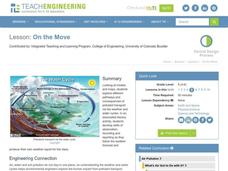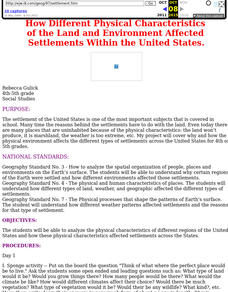Curated OER
Where in the World Is That Volcano?
Identify the Earth's major volcanoes with an earth science lesson plan. Elementary and middle schoolers locate major volcanoes on a world map. Then, in groups, they research how the volcano affects the region in which it is located.
Curated OER
Papier-Mâché Globe
Paper mache projects are great for using up paper from the recycle bin. Give your class the chance to create a three-dimensional globe out of paper mache. They'll work to make their globes as accurate as possible, adding proper colors...
National Park Service
Living & Non-Living Interactions
What better way to learn about ecosystems than by getting outside and observing them first hand? Accompanying a field trip to a local park or outdoor space, this series of collaborative activities engages children in...
E Reading Worksheets
Predictions Reading into the Future
Practice making inferences about fiction with a language arts slide show presentation. After kids read a few tips about ways to predict the next event in a story, they read several passages and try to find out what will happen next based...
University of Texas
Observing the Moon
Why does it look like there is a man on the moon? Why does the moon look different every night? These are the focus questions of a lesson that prompts class members to observe and record the nightly changes of Earth's natural...
K12 Reader
Water Carves the Land
What affect do bodies of water have on the world around us? Kids can find out by reading this passage. After reading, they answer five questions related to the text.
Skyscraper Museum
Building a Skyscraper
Creating buildings that reach hundreds of feet into the sky is no easy task. The third instructional activity in this series begins with four activities that engage young architects in exploring the major challenges that are faced when...
K5 Learning
The Moon
Second graders read a short informational text passage about the moon and answer a series of questions based on what they read.
Curated OER
Snug in the Snow
Students explore how snow helps animals survive in the wild. In this animal science lesson plan, students review key vocabulary words and discuss types of animal adaptations. Students construct shoebox to simulate the snowy environment...
Curated OER
Dripping Wet or Dry as a Bone?
Students use a sponge and water model to explore the concept of relative humidity and create a percent scale. They define humidity and saturation, build a simple humidity/saturation model, collect, predict and interpret data, and create...
Curated OER
Water, Water, Everywhere!
Learners complete a WebQuest. In this water cycle lesson, students investigate the cycle through a WebQuest activity. Learners research the water cycle through Internet resources and create a documentary video of their process.
Curated OER
Eye Spy Science
Fourth graders identify the four kinds of violent storms. Using photographs, they create "eye spy" questions for each and mount them on construction paper. They write a brief summary for each photo and share the questions with the class...
Curated OER
How Bright are the Stars?
Students observe the brightness of stars and are introduced to the concept of apparent brightness as a measure of how much light hits a detector of a surface area during a given time. In this star lesson, students make connections...
Curated OER
Wind Energy
Students explore wind energy by making a pinwheel to model a wind turbine. They experiment with their turbine by placing it in different locations for optimal energy.
Curated OER
Lesson Plans for Winter
Students participate in several winter-themed lessons. In this seasonal lesson, students study penguins and polar bears by animal masks for dramatic play. Additionally, students construct winter calendars and celebrate the season of...
Curated OER
Plane Weather
Students examine the important issue of plane safety. In groups, they are introduced to how NASA determines if it is safe to fly on a particular day given certain conditions. They use the internet to research the types of tools and...
Curated OER
On the Move
Students explore different pathways and consequences of pollutant transport via the weather and water cycles. They observe and record weather information and produce their own weather report for the class.
Curated OER
Land and Environment Affected Settlement
Students analyze the physical characteristics of different regions of the United States and how these physical characteristics affected settlements across the States.
Curated OER
How Wet Did It Get?
Students measure the rainfall/snowfall on the playground on a rainy/snowy day with a rain/snow gauge. They draw a bar graph representing the amount of water that fell and observe a satellite image of the clouds and local weather system...
Curated OER
Cultural Differences and Similarities
In this ESL activity activity, students examine cultural differences and similarities as they record their answers concerning weather, religion, sport, traditions, food, and education.
Curated OER
Poetry in Motion
Students expand their understanding and appreciation for poetry. In this poetry unit lesson, students complete 5 unit sections of multiple day activities to learn about poetry and its devices or forms.
Project SMART
Rocks and Minerals: Touch the Earth
Students complete a unit of lessons on rocks and minerals. They conduct research, write e-mail questions to geologists, write daily journal entries, label maps demonstrating types of rocks/minerals found, and create a web page that...
Pleasanton Unified School District
Temperature Review Worksheet
Young scientists examine how temperature is measured in both Fahrenheit and Celsius in a box in a weather science worksheet. They write equivalent temperatures in four examples and write the temperatures shown on four thermometers...
Other popular searches
- Kindergarten Weather Unit
- Second Grade Weather Unit
- Weather Unit Plan Clouds
- Fourth Grade Weather Unit
- Weather Unit Plans
- Severe Weather Unit
- Winter Weather Unit
- Geography Weather Unit
- Weather Unit Outlines
- Weather Unit Math
- First Grade Weather Units
- Local Weather Unit























